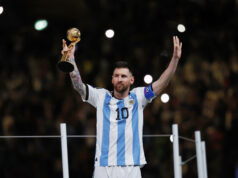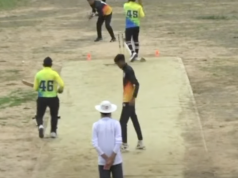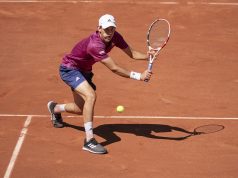After a fun run in the Copa America Centenario, the USMNT still has a lot to ground to catch up on after their 4-0 demolition by Argentina Tuesday night.
Well . . . that was fun. I’m talking about the entirety of the United States’ run in Copa America, not the ending.That’s one way to look at it. The other way — the more realistic way — could be that the United States overachieved the general opinion and achieved their goal stated by USMNT coach Jurgen Klinsmann prior to the tournament: make the semi-finals. They did both of those.
However, despite all of the hype leading into Tuesday night’s semi-final, everyone, and I mean everyone, had to know the potential, probable, and eventual outcome: the USA getting thrown back down to Earth by No. 1 Argentina 4-0.
It’s a tough loss for the U.S. to get over considering how much they’ve fought in the tournament just to get to the semi-final.
But let’s get back to Earth as well: the USMNT was never going to win that match.
Ninety-nine out of 100 times, the Americans will lose to the world soccer powers like Germany, Spain, Italy, France and Argentina.
Tuesday night’s loss wasn’t just a wake-up call to remind the Americans how far they still have to go to catch up with the rest of the world. It was a reminder of their place in the soccer world.
For what it’s worth, they also dug their own grave in Houston’s NRG Stadium: they allowed a goal as early as the third minute to Argentina’s Ezequiel Lavezzi, followed by creating a foul just outside their own 18-yard box which led to Lionel Messi’s historic free kick, then a second-half brace to Gonzalo Higuain. They made careless mistakes and had way too many turnovers which led to Argentina’s chances and goals.
“We let them dictate the pace of the game,” USMNT defender Geoff Cameron said. “We’ve played big teams before and we seemed to show well against them, but for some reason we didn’t put our best foot forward tonight.”
Argentina easily shut down the American attack – an American side who tallied no shots for the first time all tournament — and out-possessed the USMNT by the tune of 68-32 throughout the night.
The Argentines made it look easy and routine. The passing, the touches, the fluidity of their movements. Everything seemed normal for them.
The USA missed the usual starting trio of Jermaine Jones, Bobby Wood and Alejandro Bedoya, all of whom could have probably made even as much as a dent in the final box score. With three players out, Klinsmann played an international defense and an MLS attacking front.
That clearly didn’t work.
The USMNT clearly didn’t do enough to give themselves even a hint of a chance. But how do you create something even as little as a chance when going in you have none? Maybe, as a country, we were just hoping for the best. The USMNT did defeat Argentina in Copa America play 21 years ago, defeating the Argentines 3-0 in one of the most improbable results in the tournament’s history – including Mexico’s 7-0 demolition by Chile last weekend.
But that was back then in the pre-internet days and there was no miracle to be found Tuesday night, with the internet running rampant.
So, with soccer on the rise (finally) in America, how can the USA catch up with the rest of the world? Better yet, can they catch up with the rest of the world?
“Oh that’s a tough one,” Klinsmann said when asked how his team can close the gap with some of the world’s elite. “I don’t have that answer right now.”
“Today is a good day to judge where we are in program overall,” U.S. Soccer Federation President Sunil Gulati added. “We’re obviously a long way off. We knew that going in. But we knew we were a long way off when we beat Spain in 2009 or Germany or Holland last year.
“There are areas where I would have hoped for more progress and other areas where we’ve done well,” Gulati said after the USMNT’s Copa-opening loss to Colombia. “That in many ways reflects recent results …. Results over the last 18 months overall haven’t been what we would have hoped for. We’ll look at everything after the end of this competition.”
The highest points of the program of the last two decades were their lone quarterfinals appearance against Germany in the 2002 World Cup, a win against European champion and powerhouse Spain in the 2009 Confederations Cup and an appearance in the Final of the 2011 CONCACAF Gold Cup. They nearly upset Belgium in the Round of 16 in the 2014 World Cup, then upset Germany and Holland in friendlies in the summer of 2015, just before their Gold Cup run. They came from behind in both of those friendlies.
There is no helpful answer to fix the American soccer struggles simply because the best American athletes don’t play soccer. They play football or basketball because of the instant payoff after (and in some cases during) school. Majority of them come out of the inner cities where their parent(s) have to work two or three jobs to help pay for rent, or pay for their kid’s school and their sport. The majority of young American athletes are looking for a way out. The payoffs they get in rookie contracts in the NFL and NBA provide just that, along with massive fame that comes with it.
Soccer, in America, isn’t a sport where a kid can decide make a possible future even if they’re good enough at a young age. It’s seen as a business that provides kids something to do during elementary school. Families, those who can afford it, pay thousands of dollars for their kids to be on travel teams and for camps and clinics just so their kid has a shot. Usually, the kid doesn’t get that so-called shot.
Then the kids aren’t even trained correctly. The American athlete is trained to be either the fastest and, or, the strongest. They’ve been taught that usually the best athlete in those departments would succeed, not the one who is most technical or talented, or even hard-working.
The rest of the world teaches technique and the skills, both physical and mental, and then conditioning follows that.
How has the “American way” worked for U.S. soccer’s current future?
The United States’ U-23 team failed to qualify for the Olympics once again and haven’t qualified for consecutive Olympic games, while the U-20 team has been a World Cup quarterfinalist just twice since 1993, a place that the U-17s haven’t reached since 2005.
The U.S.’s ability to make a legitimate run in the 2018 World Cup is also in question with just three USMNT regulars expected to make the roster: defenders John Brooks and Deandre Yedlin and forward Gyasi Zardes. Even then, all three players will be 29 or older come kickoff in Russia.
“We need more. We struggle,” Klinsmann added. “Here in the U.S., you call a younger player a rookie at the age of 22. Well, 22 in Europe, if you’re not broken through yet, you’re done. They move you down to the third or fourth level.”
Klinsmann added that younger players need to be given a chance to fail and improve, yet he played a very veteran lineup against Argentina and throughout Copa overall.
For the record, you don’t make a lot of money at the third or fourth level in comparison to the top two tiers of European football.
The youth play a vital role in dictating where big clubs will be three, four, even five years down the road from the present day. The most successful clubs have a thriving youth system that seems to produce player after player. It may not always be an entire Starting XI’s worth, but some of the world’s top players developed at an academy of a major club.
The college program here hasn’t helped much either. Less than two percent of men’s college soccer players go pro, and it’s usually to MLS. Of the 75 picks in this year’s SuperDraft, 72 were NCAA Division I athletes. Two came from D-II and one was from a D-III school. College scholarships are rare as well with schools averaging 10 scholarships per student, according to a 2014 study. Those scholarships, as well, don’t fully cover the full amount of tuition for a student. The study includes that just nine percent of men’s high school players play in college throughout all three divisions.
The academy system that has been a staple of the international clubs has started to make its way here to the U.S. Major League Soccer teams like FC Dallas and the New York Red Bulls have already invested heavily in their youth system. FC Dallas had a very solid run to the playoffs last year with nearly an entire team of homegrown players, while the Red Bulls have succeeded with their youth, recently selling defender Matt Miazga to Chelsea last season. Two years ago we saw Yedlin, a Seattle Sounders product, make his way across the pond to Tottenham from Seattle. He’s now starting to get his skills together with Sunderland (on loan from Tottenham), both clubs of which are in the Premier League, England’s top-tier league.
“I’m not saying that the MLS wasn’t challenging for me,” Yedlin explained. “I’m saying that in Seattle I was comfortable where I was. I was around my friends. I was around my family. If I needed anything, I could always go to my mom’s house.”
Yedlin has improved defensively at the right back position while eyes start to look to Miazga to follow suit at Chelsea.
The lone bright star, however, is 17-year-old midfielder Christian Pulisic from Hershey, Pennsylvania, who burst onto the scene with top German club Borussia Dortmund, scoring twice and earning a spot and minutes with the USMNT during the Copa America tournament. He became the fourth-youngest player to score in the Bundesliga (Germany’s top league) and played the entire second half in the USMNT loss to Argentina.
He also became the youngest American in the modern era of the USMNT to score when he scored against Bolivia in a friendly back in late May.
However, he’s a vast, vast rarity of quality players that the U.S. needs but doesn’t have and isn’t getting anytime soon. There aren’t nearly close to enough players who play soccer now who are progressing as well as Pulisic, nor making the strides that he is out of high school – in Pulisic’s case, literally fresh out of high school.
You won’t find anyone like Pulisic in, or making their way to, MLS anytime soon either. Around the world and even in America, it’s still considered a minor-league brand of soccer to the rest of the world.
The closest one, if we call call him that, to Pulisic as far as potential could be Seattle Sounders forward Jordan Morris, who shined with Stanford, then denied a deal to go play with Werder Bremen in Germany to stay in the U.S. He spent the winter on trial with Werder Bremen before deciding to stay in the States.
Klinsmann acknowledged that even though Morris seems to show top-talent potential, even he still has a ways to go, as he said to the Wall Street Journal:
“Jordan knows he has to become a two-way player, has to learn [to deal with] high pressure, how to defend and how to make decisions, when to pass and when to cross. He has to improve his left foot, his aerial game. There are many areas where he knows, ‘I’ve got to work on it.’ Then you can only see that process over the next couple of years. He’s on that path where he is learning to make his own decisions. He’s learning to take things into his own hands.”
Toronto FC forward Sebastian Giovinco and New York City FC midfielder Andrea Pirlo, both of whom were almost always regulars for the Italian national team, were both left off the roster for this summer’s European Championships because they play in MLS.
“When someone decides to come to the US, he knows what he’s getting into,” Pirlo said to the Gazzetta dello Sport. “It’s clear that anyone who plays in Belgium or another league with less quality still has a chance of making the Champions League or the Europa League. And that’s what makes the difference.”
Pirlo was also critical of MLS itself, saying:
“It’s a very hard league to play in. It’s very physical, there’s a lot of running. So there is a lot of physical work and to me, in my mind, too little play.
“What I’m talking about is actually a system or culture. I don’t mean that the level of technical skills are low. I just mean there is a cultural void that needs to be filled.
“They pick them and they train them in much more than just running (in Europe). They train them in stopping the ball. Here that doesn’t happen. So when a young man becomes a professional in the United States he still has some gaps that need to be filled when playing on the field.”
If there’s anything that we can take out of the loss to Argentina, it’s that if this country wants to actually start to catch up to the soccer world in terms of quality, make consistently make it to quarter and semi-finals in major international tournaments, then the USA, not just the U.S. Soccer program itself, has to take the sport serious like the rest of the world does.
The fans also have to start holding players more and more accountable. The hype and believing and such has to stop and the expectations have to be to win. There’s nothing wrong with holding players like a Jozy Altidore, Michael Bradley, Brad Guzan accountable if the U.S.’s goal is to be among the elite of the world.
The United States can start to become a rising soccer power, or just continue to be another second-rate country in the sport. The decision awaits.












